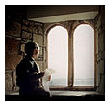Posted by Moderator on Apr 14, 2011 in Mathing | 0 comments
It’s not particularly difficult to write in numerical literary style. The last three posts in this series were about the significance of the number 496, so naturally they were all 496 words long. It’s as simple as that to make a start.
One day, I’d like to emulate my hero—the author of the fourteenth century poem, Sir Gawain and the Green Knight—but I’ve a very long way to go before I reach the exalted heights of numerical artifice he achieved.
Numerical literary style has its detractors. They come in various ilks. Some critics agree that some ancient texts show a mathematical architecture, but think the motive is numerological. Others simply deny outright that any premeditated arithmetic design exists, preferring to explain away structural details as scribal error. ‘Why would anyone,’ they scoff, ‘mix words and numbers? Why would anyone restrict the creative impulse by confining themselves to a rigid mathematical framework?’
I’d like to try these questions on a Japanese master of haiku, the 17-syllable poem of three lines in a 5-7-5 pattern. Behind the blank inscrutable stare I’d get, I’m sure there’d be the incredulous thought: ‘Don’t you get it? A true craftsman doesn’t find strict form a restraint, but freedom.’
read more
Posted by Moderator on Apr 12, 2011 in Mathing | 0 comments
Some people find it almost impossible to make the mental shift required to think of numbers and letters as marriage partners. The very idea of mathematical metaphor is a stretch too far, so they automatically assume numerology, not numeracy.
However numerical literary style is as far from numerology as astronomy is from astrology. Even Jesus makes a passing reference to it in a famous passage: ‘…till heaven and earth pass away, one jot or one tittle will by no means pass from the law till all is fulfilled…’ Matthew 5:18 NKJ
It’s no coincidence that just one verse removed from this remark, He refers to the scribes, known in Hebrew as the Sopherim. A scribe’s three main tasks were:
read more
Posted by Moderator on Apr 1, 2011 in Mathing | 0 comments
There’s a famous story about Karl Friedrich Gauss, one of the most distinguished mathematicians of all time. His talent was evident from an early age. His teacher told the class to add up all the numbers from one to 100. Moments later, Gauss appeared at his desk with the correct answer: 5050. The boy later to be known as ‘The Prince of Mathematicians’ had figured out a short-cut. His cunning method of calculation actually works for all similar situations or for so-called ‘triangular’ numbers. Triangular numbers have this name because, if they are arranged in rows of dots on paper, they form perfect triangles. However, they can also be found by adding successive whole numbers together. For instance, 171 is the eighteenth triangular number because all the numbers from one to 18 add to 171 while 153 is the seventeenth triangular number because all the numbers from one to 17 add to 153.
read more
Posted by Moderator on Mar 31, 2011 in Feature, Mathing | 1 comment
Mention the word ‘mathematics’ and most people tend to squirm. But I love the subject and I delight in finding it in unexpected places. I’m always thrilled to discover a new spot where God has pulled out all stops in a virtuoso display of numeracy.
Most people don’t cope well on being told the Bible is full of mathematics. They think numeracy equals numerology. But they are as different as astronomy and astrology.
read more


